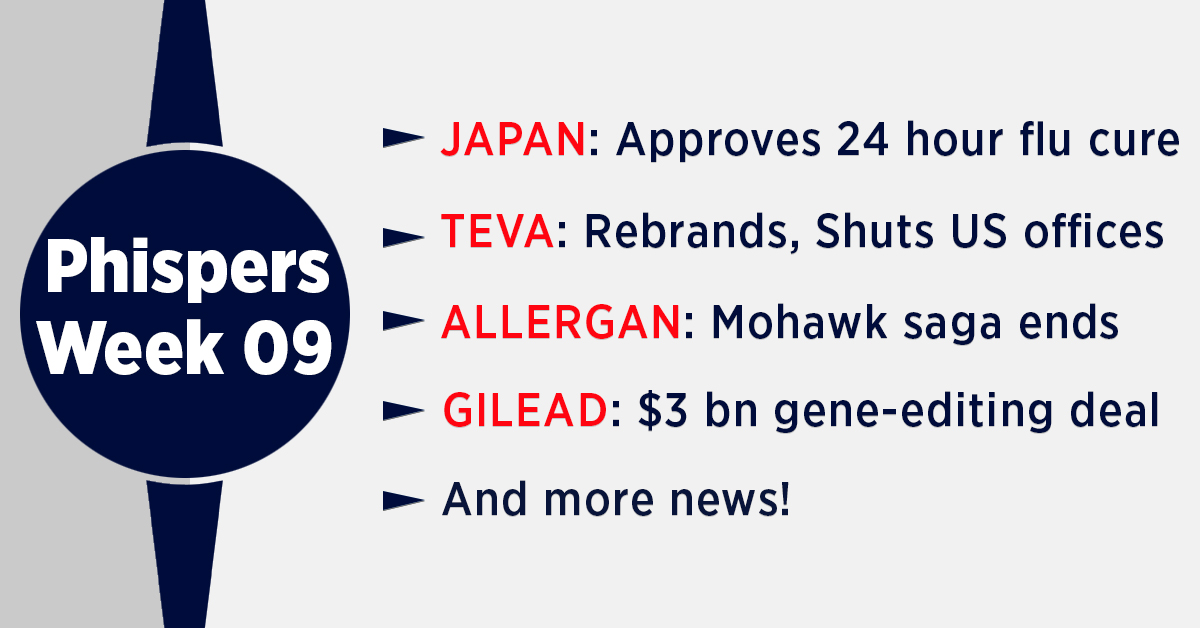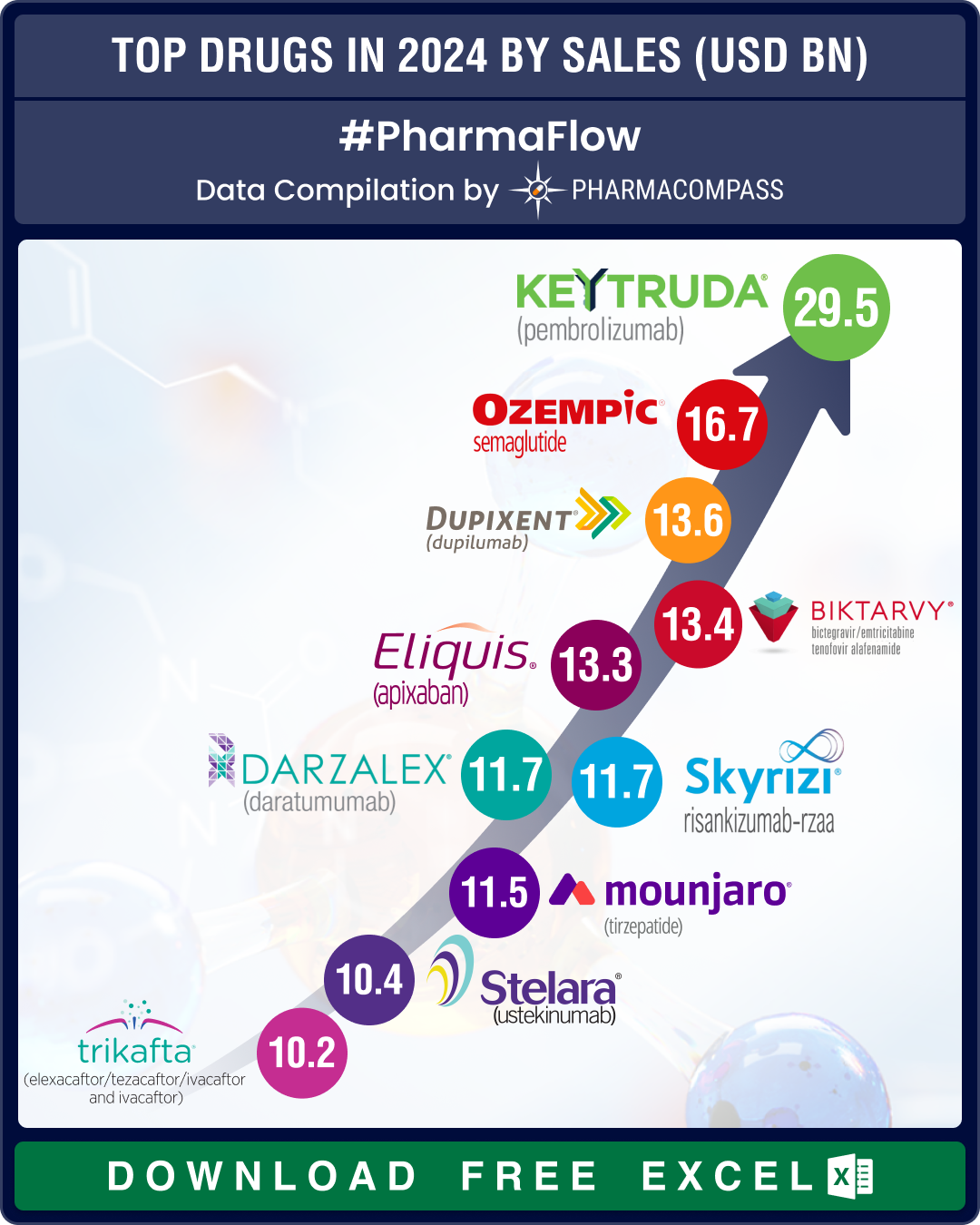
This week Phispers covers Xofluza, a drug approved in Japan that kills the influenza virus in 24 hours. It is poised to give Roche’s Tamiflu a run for its money. We also bring you an update on the beleaguered drug maker Teva, which shuttered offices in the US, and repositioned its brand. Meanwhile, in India, the Sun Pharma promoter said drug companies must learn from the auto industry. Sun had only three observations during a recent USFDA inspection of its Halol plant. Allergan’s deal with the Mohawk tribe got nixed by the US patents office and Gilead entered into a US$ 3 billion gene-editing deal with Sangamo.
Japan approves Shionogi’s Xofluza — a pathbreaking drug that cures flu in as soon as a day
Swiss drug giant Roche could face serious competition for Tamiflu in the years to come. In Japan, the government has approved baloxavir marboxil tablets, a drug developed by Shionogi & Co Ltd.
The drug, christened Xofluza, is a treatment for influenza A and influenza B. The Osaka-based drug company says Xofluza can kill the influenza virus in as soon as 24 hours, although some symptoms could last longer.
Unlike drugs like oseltamivir (Tamiflu) that inhibit the action of neuraminidase (an enzyme that frees viruses from the infected cells’ surface), baloxavir marboxil prevents replication of the virus. Moreover, this pathbreaking drug needs to be taken in a single dose, regardless of the patient’s age. Oseltamivir, on the other hand, needs to be taken twice daily over five days to treat the flu.
Shionogi said Xofluza will go on sale in Japan as soon as its price is decided by the government. However, the drug would not be up for approval in the United States before 2019.
Each year, influeza kills as many as 650,000 people worldwide. As of today, Roche’s Tamiflu is the most common antiviral used to treat the flu.
Shionogi had sought the Japanese government’s approval for Xofluza only four months back. The drug was approved under the fast track drug review system introduced by the Japanese government in 2015, to allow a medicine with high potential to be launched in Japan before other countries.
Teva redefines
its brand, shutters NY, DC offices; Buffet picks up stock
Israeli generic drug giant Teva Pharmaceutical has redefined its brand after 115 years of being in existence. The new Teva brand is a ‘unified identity that spans both the company's specialty and generic portfolios’.
It positions Teva as a “trustworthy partner to the patients, caregivers and healthcare professionals,” Iris Beck-Codner, Teva executive vice president of global brand and corporate communications, said.
The brand rollout in the US and Canada has been underway since 2016. The company has used a ‘hyperlocal’ strategy that uses a different implementation plan for every geography based on unique research and insights. Such a strategy has been used in Russia, France and Argentina for the brand rollout.
The rebranding comes just two months after CEO Kåre Schultz’s announced a restructuring plan for Teva, as the company was saddled with a US$ 40 billion debt, after it bought Allergan’s generic-drug business in August 2016.
Meanwhile, the Israeli drug maker has closed its offices in New York and Washington, Schultz said last week. According to him, the New York offices were very expensive, and the Washington offices were used mainly by company lobbyists. Since Teva is part of the Generic Pharmaceutical Association —a trade association in the US representing generic manufacturers and distributors —the company does not need lobbyists of its own, he said.
Meanwhile, Teva’s short-sellers got a shock on Valentine’s day, when they heard that Warren Buffet’s Berkshire Hathaway has made an investment of US$ 358 million in Teva’s stock. Though the investment doesn’t fix any of Teva’s issues, “it does represent a notional short interest in the company,” according to financial analytics firm S3 Partners.
Teva's ADRs (American Depository Receipts) had collapsed by 65 percent between August and November 2017, as its best-selling product — Copaxone, a medicine for multiple sclerosis — met with competition from generic therapies.
The investment by Berkshire possibly suggests the Teva stock has bottomed out. “The time to buy a stock is when it’s out of favor and nobody wants it,” a report in InvestorPlace said. “Buffett is still a master when it comes to finding value nobody else sees,” the report added.
Three
observations for Sun post FDA inspection; CEO says learn from auto industry
India’s leading drug company Sun Pharmaceutical Industries draws 40 percent of its revenues from its Halol site in Gujarat. Therefore, when Sun recently informed stock exchanges that it had received only three observations from the US Food and Drugs Administration (USFDA), it was apparent that Sun may be getting better at resolving the issues at the critical site.
According to news reports, the three observations may be handled without a long-drawn re-inspection. Sun has informed the stock exchanges that it will respond to the USFDA note within the 15 day deadline to revert with an action plan. According to analysts, if things go as planned, the Halol site may be cleared within three months.
At another site in Dadra, Sun has been able to solve its quality issues quickly. In April 2017, the USFDA had found as many as 11 quality and procedural violations at the unit. In October 2017, the company announced it had received an establishment inspection report (EIR) from the agency. An EIR implied that the April inspection had been closed and the unit had been cleared for production.
In June 2015, PharmaCompass had reported on how pharmaceutical executives should gain manufacturing insights from top aerospace, automotive and other non-pharma companies.
At a recent CEO roundtable at the Indian Pharmaceutical Forum, Dilip Shanghvi, managing director, Sun Pharma, said something similar. He said the pharmaceutical industry could do well to take a page out of the automobile industry’s book when it comes to handling attrition and quality.
Quoting the example of the Motherson Group, whose chairman and co-founder V C Sehgal is an independent director on Sun Pharma’s board, Shanghvi said the group’s flagship auto ancillary company — Motherson Sumi — saw zero defects in the parts supplied to multinational carmakers. The attrition rate at Motherson Sumi was as low as two per cent. In the pharma industry, attrition rate is estimated to be around 20 per cent.
End of the Mohawk saga — Allergan deal gets nixed by US patent office
The case of Allegan seeking sovereign immunity for its dry-eye drug Restasis by granting exclusive licenses for its patent to the St. Regis Mohawk tribe has now been resolved.
In an eagerly awaited ruling, the Patent Trial And Appeal Board of the US Patent And Trademark Office ruled the tribe cannot claim sovereign immunity to avoid an inter partes review for Restasis,
“Upon consideration of the record, and for the reasons discussed below, we determine the Tribe has not established that the doctrine of tribal sovereign immunity should be applied to these proceedings. Furthermore, we determine that these proceedings can continue even without the Tribe’s participation in view of Allergan’s retained ownership interests in the challenged patents. The Tribe’s Motion is therefore denied,” the ruling said.
Allergan, which was facing a patent challenge for Restasis from Mylan, Teva and Akorn, had partnered with the Mohawk Tribe in September last year, granting the tribe (which is a recognized sovereign tribal government) exclusive licenses for the patents of the drug. The Mohawks were to receive an upfront fee of US$ 13.75 million and annual royalties under the agreement.
Gilead enters into a US$ 3 billion gene-editing deal with Sangamo
Gilead Sciences has strengthened its position in the emerging cell therapy for cancer with a US$ 3 billion agreement to use Sangamo Biosciences’ gene-editing platform for the new cell-based cancer therapies.
As per the deal, Gilead can access Sangamo Therapeutics’ zinc finger nuclease (ZFN) technology. In August last year, Gilead had announced that it is acquiring CAR-T specialist Kite Pharma for US$ 12 billion. And in December, Gilead and Kite announced they have taken over another CAR-T tech company — Cell Design.
CAR-T is short for chimeric antigen receptor (CAR)-T cell. This is a type of treatment in which the cancer patient’s T cells (a type of immune system cells) are modified in a laboratory so that they attack the cancer cells. Large numbers of the CAR T cells are grown in the laboratory and given to the patient by infusion.
Kite will use Sangamo’s ZFN gene editing platform to create next-generation, off-the-shelf CAR-T therapies to bolster its position as a front-runner in the growing cell therapy space.
As per the deal, Gilead is paying Sangamo US$ 150 million upfront for Kite to use Sangamo’s ZFN technology to develop up to 10 off-the-shelf CAR-T therapies. It also stands to receive up to US$ 3 billion in milestones — US$ 300 million per product — as well as tiered royalties on sales.
The deal with Sangamo means rivals in the CAR-T therapy such as Novartis, Celgene/Juno and off-the-shelf specialist Cellectis won’t be able to use the ZFN technology in their own gene-editing toolboxes.
Impressive findings from final stage study on Novo’s new diabetes pill
Novo Nordisk, the world’s largest manufacturer of diabetes drugs, presented the first successful data from a large final stage study of a pill, generically known as semaglutide. Novo hopes this pill will transform the diabetes market.
As compared to a placebo, in the first of 10 Phase III trials, oral form of semaglutide demonstrated “significant and superior” improvements in the long-term blood sugar levels.
The once-daily pill belongs to a blockbuster class of treatments known as GLP-1s that stimulate insulin production. The first such treatment was derived from the venomous bite of North America's Gila monster lizard. So far, all such treatments have been injections.
There is increased pricing pressure in the market for diabetes, worldwide. Therefore, oral form of semaglutide is crucial for ensuring the group's long-term growth.
Novo Nordisk said it aims to provide data from the remaining nine trials this year and expects to submit the drug for regulatory approval in 2019, ahead of the drug’s potential launch in 2020.
The PharmaCompass Newsletter – Sign Up, Stay Ahead
Feedback, help us to improve. Click here
Image Credit : Phisper Infographic by PharmaCompass is licensed under CC BY 2.0
“ The article is based on the information available in public and which the author believes to be true. The author is not disseminating any information, which the author believes or knows, is confidential or in conflict with the privacy of any person. The views expressed or information supplied through this article is mere opinion and observation of the author. The author does not intend to defame, insult or, cause loss or damage to anyone, in any manner, through this article.”






